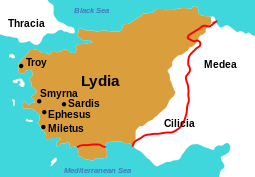|
Greek city of Magnesia ad Sipylum in Lydia
Bronze 12mm (1.81 grams) Struck circa 3rd-1st Centuries B.C.
Reference: Sear 4706; B.M.C. 22.137,3
Certification: NGC Ancients VF 4936277-005
Laureate head of Zeus right.
MΑ / ΣΙΠΥ either side of bunch of grapes; monogram beneath.
On the northern slopes of Mt. Sipylus, north-east of Smyrna, Magnesia was the scene of the famous defeat of Antiochos the Great by the Romans in 190 B.C.
You are bidding on the exact item pictured, provided with a Certificate of Authenticity and Lifetime Guarantee of Authenticity.
Magnesia ad Sipylum (Greek: Mαγνησία του Σιπύλου) (modern Manisa, Turkey), was a city of Lydia, situated about 65 km northeast of Smyrna (now İzmir) on the river Hermus (now Gediz) at the foot of Mount Sipylus. The city should not be confused with its older neighbor, Magnesia on the Maeander, both founded by colonists from the Greek region of Magnesia.
The first famous mention of the city is in 190 BC, when Antiochus the Great was defeated in the battle of Magnesia by the Roman consul Lucius Cornelius Scipio Asiaticus. It became a city of importance under Roman rule and, though nearly destroyed by an earthquake in the reign of Tiberius, was restored by that emperor and flourished through the Roman empire. It was an important regional centre through the Byzantine Empire, and during the 13th century interregnum of the Empire of Nicea. Magnesia housed the Imperial mint, the Imperial treasury, and served as the functional capital of the empire until the recovery of Constantinople in 1261. Magnesia was one of the few towns in this part of Anatolia which remained prosperous under the Turkish rule.
Landmarks
 Early 20th century postcard image of the Hittite statue of the Mother Goddess Kybele in Mount Sipylus Early 20th century postcard image of the Hittite statue of the Mother Goddess Kybele in Mount Sipylus
There are two famous relics of antiquity. The first is the Niobe of Sipylus (Aglayan Kaya), a natural rock formation, on the lowest slopes of the mountains in the middle of town. The second is a carving, allegedly of Cybele (Suratlu Tash) about 100 meters up the mountain about 6 km east of the town. This is a colossal seated image cut in a niche of the rock, of Hittite origin, and perhaps that called by Pausanias the very ancient statue of the Mother of the Gods, carved by Broteas, son of Tantalus, and sung by Homer. It can be seen by driving into a parking lot at a children’s playground.
Near the carving lie many remains of a primitive city, and about a kilometer east is the rock-seat conjecturally identified with Pausanias’s Throne of Pelops. There are also hot springs and a sacred grotto of Apollo. Parts of the major fortifications built during the Empire of Nicea remain evident.
Magnetism
One of the regions colonized by the Magnetes was a primary source for mysterious stones that could attract or repel each other, possibly leading to the modern term for magnets and magnetism. Some suggest that it was Magnesia ad Sipylum, others that it was the Magnesia regional unit in Thessaly; this has been debated both in modern times and in antiquity without resolution.
 Lydia was an Iron Age kingdom of western Asia Minor located generally east of ancient Ionia in the modern western Turkish provinces of Uşak, Manisa and inland İzmir. Its population spoke an Anatolian language known as Lydian. Lydia was an Iron Age kingdom of western Asia Minor located generally east of ancient Ionia in the modern western Turkish provinces of Uşak, Manisa and inland İzmir. Its population spoke an Anatolian language known as Lydian.
At its greatest extent, the Kingdom of Lydia covered all of western Anatolia. Lydia (known as Sparda by the Achaemenids) was a satrapy (province) of the Achaemenid Persian Empire, with Sardis as its capital. Tabalus, appointed by Cyrus the Great, was the first satrap (governor). (See: Lydia (satrapy).)
Lydia was later the name of a Roman province. Coins are said to have been invented in Lydia around the 7th century BC.
|









 Early 20th century postcard image of the Hittite statue of the Mother Goddess Kybele in Mount Sipylus
Early 20th century postcard image of the Hittite statue of the Mother Goddess Kybele in Mount Sipylus  Lydia was an Iron Age kingdom of western Asia Minor located generally east of ancient Ionia in the modern western Turkish provinces of Uşak, Manisa and inland İzmir. Its population spoke an Anatolian language known as Lydian.
Lydia was an Iron Age kingdom of western Asia Minor located generally east of ancient Ionia in the modern western Turkish provinces of Uşak, Manisa and inland İzmir. Its population spoke an Anatolian language known as Lydian.




